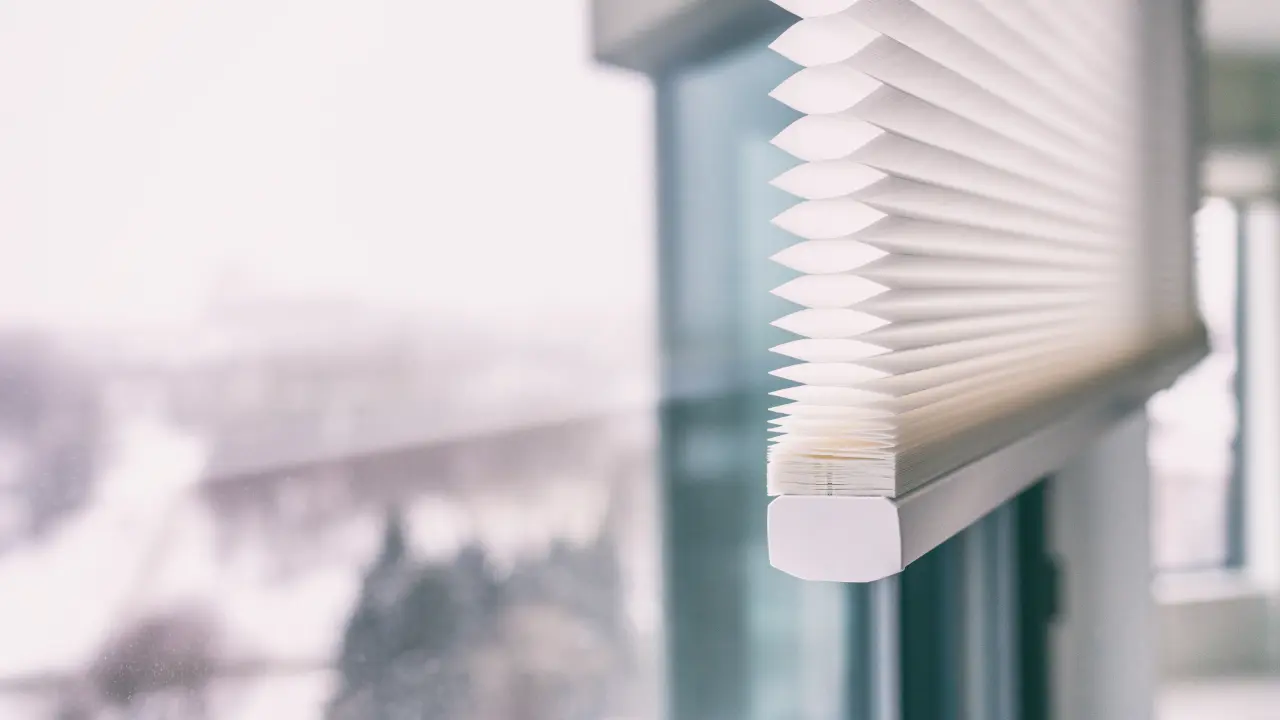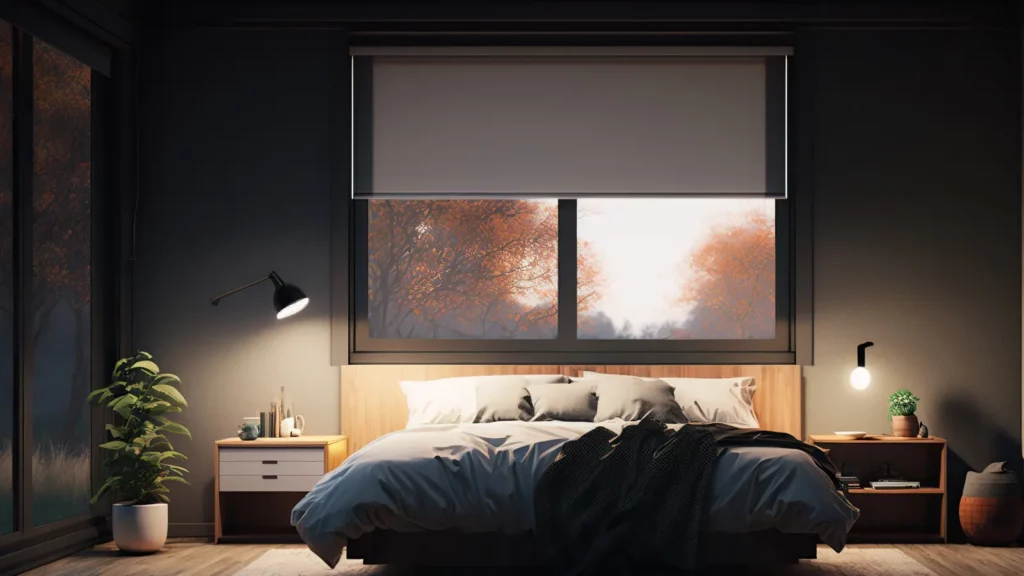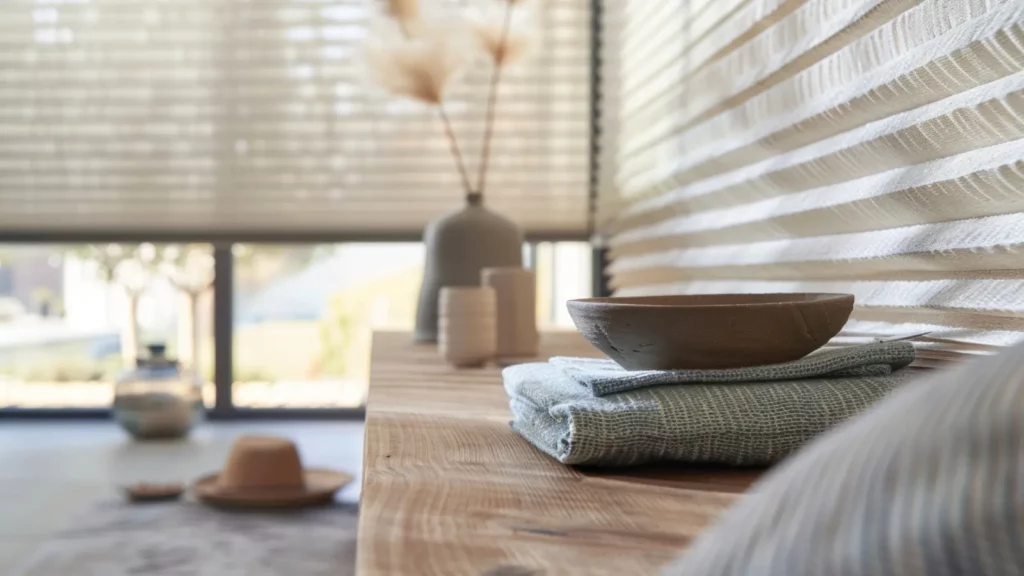Choosing the Most Energy-Efficient Window Treatments for Lower Bills

Are you weary of soaring energy bills?
Please don’t answer that — it’s a rhetorical question.
No one likes shelling out hard-earned cash (or credit) to the power companies — not even their shareholders.
But did you know that a simple change in your window treatments can make a big difference? Energy-efficient window treatments spruce up your space and slash those hefty power bills.
According to the US Department of Energy, a whopping 25-30% of a home’s heating and cooling escapes through windows! And while installing tightly sealed double-paned windows is a good idea, you can do more to prevent the waste.
Energy-efficient window treatments will lower your power bills, help regulate indoor temperatures, and perhaps even qualify you for a federal tax credit.
Now, let’s explore some of the better options.
7 Types of Energy-Efficient Window Treatments
1. Cellular Shades
Cellular shades have a honeycomb design that traps air in their pockets, creating an insulation layer between the window and the room. The more layers they have, the better their insulation value.
Properly installed cellular shades can reduce energy bills by up to 25%.
They come in a variety of colors and patterns. They’re easy to install, and you can raise or lower them just like blinds, depending on the light and privacy you desire.
2. Insulated Curtains
Insulated curtains are like thermoses for your windows — they keep hot things hot and cold things cold. They’re constructed from heavyweight materials, typically featuring a layer of insulating foam backed by a reflective film that redirects heat to its source.
This design forms a barrier between the window and the room, blocking out cold drafts in the winter and the sun’s heat in the summer.
Insulated curtains are available in a wide range of styles and colors, so they can be just as aesthetically pleasing as practical.
3. Roller Shades
Roller shades have a minimalist design that complements most decor. These shades roll their fabric into a casing, allowing easy light and heat control.
Fabrics with light colors on the outside can help reflect sunlight and keep your rooms cooler during the summer, while darker colors provide more privacy and heat retention in winter.
Adding an insulated lining to your roller shades can bump up their energy efficiency. Insulated linings form a barrier against heat transfer to keep your home comfy and energy efficient. Plus, the lining increases opacity for greater privacy.
4. Roman Shades
Roman shades offer the same insulating benefits as curtains but with space-saving properties and unique elegance. Available in various fabrics and opacities, they offer excellent insulation and a tailored look.
The secret to their energy efficiency lies in their design. They form a snug layer when lowered, preventing heat from escaping during winters and blocking sunlight in summers.
When raised, they stack neatly in even folds to let in natural light and present an unobstructed view.
Heavier, densely woven fabrics offer better insulation and light control. Adding a layer of insulated lining can boost their energy efficiency even further.
5. Layered Window Treatments
Layering window treatments is the superhero team-up of the window world. By combining two or more types of window coverings, you gain the benefits of each, creating a super shield against energy loss.
For example, cellular shades with insulated curtains can beef up insulation to trap more heat during the winter and keep out the sun’s rays in the summer. Layering gives you more control over light and privacy while adding depth and interest to your room’s aesthetic.
6. Plantation Shutters
These elegant window coverings are typically made from wood, a natural insulator. The thick, solid construction of the wooden slats provides a substantial barrier against heat transfer.
In the sizzling summer months, plantation shutters can be a game-changer as they effectively block intense solar radiation, keeping the interiors of your home comfortably cool.
Furthermore, you can adjust the angle of the slats to regulate the amount of sunlight entering the room while preventing a greenhouse effect. The balance between light control and insulation makes plantation shutters a stellar choice for energy conservation.
7. Window Films
Think of these as a sunscreen for your windows. Thin, adhesive films applied directly to window glass reduce heat and glare while the room basks in natural light. These films come in various tints and finishes, so you can choose one that best suits your style and needs.
Window films also provide an extra layer of security to your home, making windows more resistant to shattering and, in some cases, obscuring the view into your home from the outside.
Factors to Consider
Before purchasing window treatments, weigh the following factors for maximum energy efficiency:
- Orientation: The direction your windows face affects the amount of sunlight and heat they receive. North-facing windows get little direct sunlight, while south-facing ones get the most. Western windows often have the hottest exposure.
- Climate: Your local climate influences the type of window treatments you may need. In colder climates, the aim is to trap heat inside, so heavily insulated curtains or cellular shades would be most effective. Warmer climates are ideal for reflective window films or light-colored roller shades to deflect heat.
- Window Size and Type: Larger windows may need heavier or more substantial treatments to effectively manage heat and lighta. Bay windows, casement windows, or skylights may require custom treatments.
- Material and Fabric: The material of your window treatment significantly impacts its energy efficiency. Opt for thick, tightly woven fabrics for better insulation.
- Insulation Properties: Look for treatments with insulating properties that suit your climate. Consider the R-value, indicating the material’s resistance to heat flow.
- Interior Design: You wouldn’t want to compromise your home’s aesthetic for energy efficiency. Make sure your window treatments match or complement your overall interior design theme and color scheme.
- Budget: Window treatments can range from inexpensive to high-end. Calculate your budget beforehand and remember that while some treatments may be pricier, they could offer greater energy savings in the long run.
- Maintenance: Some window treatments are easier to clean and maintain than others. For example, cellular shades may attract dust and allergens, while window films are comparatively easier to clean.
Automating Your Treatments for Added Efficiency
Automated motorized window treatments let you program your shades, blinds, or curtains to open, close, or adjust at specific times of the day. This means you can schedule your window treatments to close when the sun is at its peak, reducing heat gain, and open them when it’s cooler to take advantage of natural light.
Automation also contributes to maintaining a consistent indoor temperature, reducing the strain on your HVAC system. Moreover, when integrated with other smart home devices, like thermostats or light sensors, the system can respond to real-time temperature or light level changes, ensuring optimal energy efficiency.
As a bonus, automated window treatments provide enhanced convenience and security while giving your home a more modern and high-tech aesthetic.
Where to Buy Energy-Efficient Window Treatments
Now that you know the different types of energy-efficient window treatments and factors to consider, you may be ready for a purchase. Here are some places to look:
- Home Improvement Stores: Brick-and-mortar stores offer a broad selection of window treatments, from simple roller blinds to custom shutters.
- Online Retailers: Online shopping has advantages, like comparing prices and reading reviews from the comfort of your home. Many online retailers offer free samples of their colors and materials.
- Local Window Treatment Experts: You may want to consult with a professional window treatment company for expert advice on the best treatments for your home and budget.
In Los Angeles, Aero Shade is the premier window treatment store, with over half a century of experience in the business. Our clients include top architects, designers, entertainment luminaries, and thousands of homeowners throughout Southern California.
We can customize and motorize any window treatment, regardless of size or shape. Call us for a free, in-home, no-obligation estimate. It’s the first step towards the window treatments of your dreams. 323-457-2835.
FAQs: More about Energy-Efficient Window Treatments
Q: Are energy-efficient window treatments expensive?
Energy-efficient treatments vary in price. They may cost more upfront but pay off in the long run through energy savings. Plus, some coverings can qualify you for a tax credit.
Q: Do these energy-efficient treatments work for all types of windows?
There are suitable options for all window types and sizes.
Q: Can I install these treatments on my own?
While some treatments are DIY-friendly, professional installation ensures optimal performance.
Q: Do energy-efficient treatments look as utilitarian as they sound?
Not at all! Today, energy-efficient treatments come in various styles, colors, and patterns to match your decor. With the right choice, you can elevate the look of your space while being energy-conscious.
Q: Can I use an energy-efficient treatment with my existing window coverings?
Layering treatments is a great way to boost insulation and add depth to your windows. For example, pairing curtains with blinds or shades can increase energy efficiency while providing flexible light and privacy control.
Q: What is the lifespan of energy-efficient window treatments?
Energy-efficient treatments can last many years with proper care and maintenance. The expected lifespan often depends on the product’s material and quality.
Q: Are there energy-efficient treatments available for large or unusually shaped windows?
Yes, although you may need a customized solution. At Aero Shade, we’ve customized treatments for windows of all shapes and sizes.
Q: Can I use automation with my energy-efficient window treatments?
Many energy-efficient window treatments can be automated for ease of use and even higher energy savings. Automated shades or blinds can be scheduled to open or close based on the time of day, maximizing natural light and heat control.
Q: To be energy-efficient, do I need to replace all my window treatments at once?
Not necessarily. While replacing all your window treatments at once may provide the maximum energy benefit, even a partial replacement or addition can help reduce energy consumption. Start with the windows that receive the most sunlight or are the least insulated.


